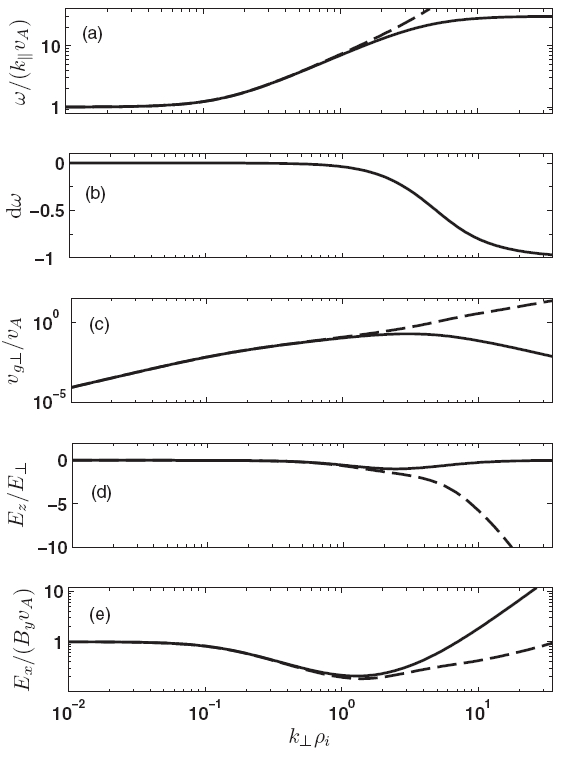Kinetic Alfven waves (KAWs) have been observed in aurora regions, the ionosphere, and plasma sheet-tail lobe boundary. One of the most important features of KAWs is that the wave electric field fluctuations parallel to the background magnetic B0 field are capable of leading to Landau damping and plasma heating. So such waves are of interest in various situations involving strong gradients transverse to B0, parallel electric fields, and plasma energization.Related examples of applications are the Earth’s aurora and substorms, planetary magnetospheres, comets, extragalactic jets, solar radio bursts, solar flares, minor heavy ion acceleration in coronal holes and the heating of solar coronal loops. The main physical properties of KAWs can be described by the two-fluid and kinetic or gyrokinetic equations. The two-fluid description assumes that the velocity distribution function of the particles is isotropic and the particles can be described by the equations for ideal fluids in a self-consistent way. The fluid models can provide a reasonably approximate description of the plasma behavior, the development of which has a rich history in plasma and space physics. On the other hand, the kinetic description of KAWs can provide important kinetic effects such as Landau damping and gyroradius orbit averaging. As a low-frequency limit of the kinetic theory based on averaging over the gyration of charged particles about a mean magnetic field, gyrokinetic theory has been developed intensively in the past.The gyrokinetic approach orders out fast MHD waves and the cyclotron resonance, but retains finite Larmor radius effect and collisionless wave–particle interactions via the Landau resonance. It was recognized to be appropriate for the study of astrophysical plasmas, including galaxy clusters, accretion disks around compact objects, the interstellar medium, solar corona, and solar wind. The main reason for the present comparative study is that for practical or computational purposes, a fluid model is simpler and faster to evolve numerically, although in principle, a kinetic approach would seem closer to the real world and can provide a rigorous treatment of the physics for the complex aspects of particle–field interactions. There are two main aims for this research: (1) to explore the similarities and differences in both models for values that can be determined from available observations in the solar and space plasma environments, and (2) to check the validity and limits of the two-fluid model for KAWs. From the linear KAW dispersion relation for gyrokinetics, the wave group velocity and electromagnetic polarizations are obtained analytically, and the gyrokinetic wave properties are compared with those of the two-fluid model. The results show that both models agree well with each other not only in the long wavelength regime (>> the ion gyroradius ρi) for all cases considered, but also in wavelengths ~ ρi and << ρi (still much larger than the electron gyroscale) for a moderate or low and a high ion/electron temperature ratio T0i/T0e, respectively. However, the fluid model calculations deviate strongly from the gyrokinetic model at scales < ρi for a relatively low T0i/T0e due to the electron gyroradius effect. Meanwhile, the plasma βi can make the gyrokinetic dispersion relation of KAWs become complex and sometimes have an oscillation-like structure. With the inherent simplicity of the fluid theory, these results may improve our understanding of the applicability of the two-fluid model, and may have important implications for computer simulation studies of KAWs in the solar and space plasma surroundings. 
By with for YANG Lei Figure 1. (a) Dependence of the normalized KAW frequency ω/(k||vA), (b) relative difference in the wave frequency dω, (c) wave group velocity vg⊥/vA, (d) electric filed ratio Ez/E⊥, (e) and electric/magnetic field ratio Ex/(ByvA) on the normalized transverse wavenumber k⊥ρi for an ion/electron temperature ratio T0i/T0e = 0.01 and ion plasma βi = 0.01. Plotted are analytical solutions to the two-fluid model (solid line) and gyrokinetic model (dashed line). Here, the propagation angle θ = 89◦. The work by YANG Lei has been accepted for publication in The Astrophysical Journal,available at http://iopscience.iop.org/0004-637X/792/1/36/pdf/0004-637X_792_1_36.pdf |
